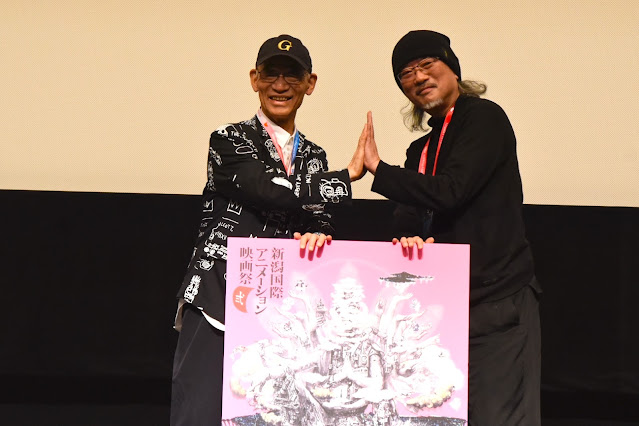Niigata 2024 Redux: Is anime from beyond Japan still 'anime?' Japan Times column
Niigata film festival showcases cutting-edge overseas talent
Less than a week after octogenarian Hayao Miyazaki scored his second Academy Award, another 80-something anime legend, “Gundam” creator Yoshiyuki Tomino, greeted a packed auditorium at the second annual Niigata International Animation Film Festival (NIAFF). Striding onstage in a funky black-and-white jacket, billowing slacks and a baseball cap, Tomino urged the artists in the audience to surpass his longtime rival, who he said had raised the artistic bar for the medium — “Let’s beat Miyazaki!”
NIAFF is devoted to feature-length animation over animated shorts, making it the largest festival of its kind in Asia. The 2024 edition showcased over 65 films, nearly 20 more than last year, from countries as far-flung as Latvia, Israel and Ireland, with 12 films from 11 countries in competition. Entries surged 250% over 2023, with 40% coming from Europe, and rising numbers from Asia and the Middle East — the latter being the next major growth market for anime and Japanese popular culture.
But Tomino’s presence and his call to eclipse Miyazaki underlined another reality in the domestic anime business: Many of its luminaries are aging into retirement. As NIAFF’s program revealed, it may be anime-inspired artists from overseas who are now at the cutting edge of the art form.
Two-dimensional techniques and stylizations, the crowning achievement of Japan’s animation legacy (even when enhanced by computer-generated visuals), dominated this year’s lineup. The stories were psychologically rich and emotionally dark — another hallmark of anime compared to the more conventionally moralistic and uplifting titles from American stalwarts such as Disney and Pixar. Artists from around the world raised on anime are now creating their homegrown versions of it.
Colombian director Diego Felipe Guzman, 39 — whose dystopian, Kafkaesque odyssey, “The Other Shape,” draws its color palette, misshapen faces and rubbery physiques from Masaaki Yuasa (“Inu-Oh”) and the late Satoshi Kon (the robot from “Paprika” has a cameo) — tells me that the innovations of Japan’s anime artists are what first drove him to make animation. He fell in love with Miyazaki’s work as a child; as an adult, Yuasa, Kon and “Akira” creator Katsuhiro Otomo kept him going. “For me, the lives of these giants of Japanese animation are an inspiration that reaffirms my decision to become an animator, despite all the obstacles.”
Joel Vaudreuil, director of this year’s grand prix-winning “When Adam Changes,” grew up in a small town in suburban Quebec, where local television networks broadcast anime series licensed from Fuji TV, including the whimsical “Demetan the Frog.” Vaudreuil, also an illustrator and writer, is particularly attracted to what he calls “the looseness and freedom of storytelling” in Japan’s hand-drawn animated works. In some of the big-budget American CGI productions, he says, “the editing is too tight. It looks like they’re trying to mask a lack of ideas.”
Vaudreuil has presented his film at festivals in Europe and North America, but he says the intimacy of NIAFF affords unique opportunities. “(In Niigata), it’s still possible to encounter masters of animation up close. They’re so great that you expect them to magically glow, but they’re actually so accessible.”
Like most film festivals, NIAFF offers a surfeit of riches that pose head-spinning choices. Inevitably, screenings and talks overlap in the schedule. And seeing more than three films a day can induce cinematic vertigo in the most ardent attendee.
The opportunity to meet anime creators and producers far from their Tokyo studios and offices is one of NIAFF’s biggest attractions. Away from whiteboards, deadlines and back-to-back meetings, and suddenly plunked into a slower-paced city, participants from Japan and around the world are at ease to reflect on what they do and why.
Over a casual breakfast, I learned from Studio Chizu founder Yuichiro Saito, one of this year’s three competition judges, that director Mamoru Hosoda (“Belle,” “Summer Wars”) is developing his most ambitious project yet: a film that will take up Tomino’s challenge and may be Hosoda’s magnum opus.
Hosoda is one of many artists who formerly worked under Miyazaki but embarked on their own after creative disagreements. Another is Sunao Katabuchi (“In This Corner of the World”), who spent an afternoon explaining to me the dense research and revolutionary goals behind his forthcoming epic, “The Mourning Children,” a project seven years in the making.
The film is set in Kyoto in the Heian Period (794-1185), and legendary “Pillow Book” author Sei Shonagon is one of its main characters. Katabuchi will use the art of animation to expose the realities of the age: the unhygienic environment and practices of its people, but also their intuitive wisdom when facing down frequent plagues and natural disasters.
Echoing Japan’s more recent encounters with the pandemic and the calamities of 3/11, Katabuchi’s “Mourning Children” aims to perform an even more ambitious modern task: excavate the female perspective from male-dominated historical narratives imposed upon the Heian Period by scholars of the Meiji Era (1868-1912).
Is it a feminist retelling of ancient Japanese history? “Yes, you could say that,” he says.
Director Sunao Katabuchi at NIAFF 2024 (Matt Schley)
A retrospective of works by the late Isao Takahata, Katabuchi’s hero and Miyazaki’s longtime artistic partner, grounded NIAFF in the roots of ancient anime history. The screening of his 1982 classic, “Gauche the Cellist,” was attended by Takahata’s wife and eldest son, who movingly noted that the film was a family favorite because it focused on the beauty of music.
Nora Twomey, an Irish animator, co-founder of studio Cartoon Saloon (“Wolfwalkers,” “The Secret of Kells”) and a jury member at NIAFF, came away from this year’s festival deeply impressed by its growth and scope. “I only hope it doesn’t lose its informal vibe,” she tells me, “where everyone mixes together and conversation flows.”




.jpg)